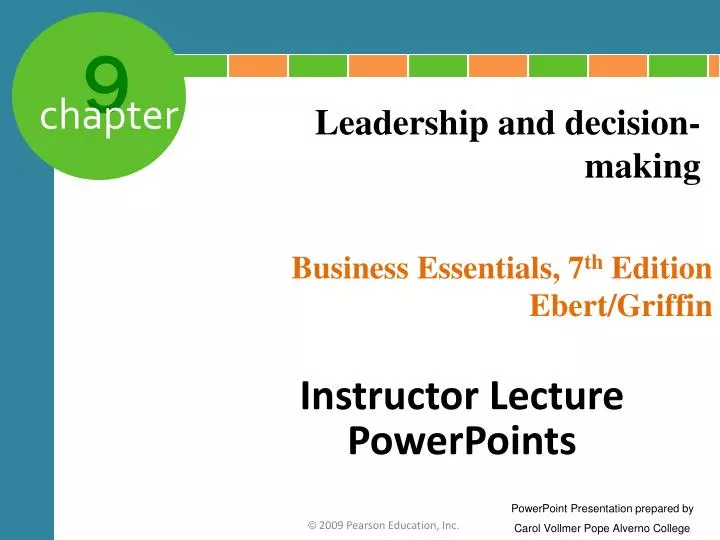Business 7th Edition Powerpoints Griffen and Ebert Chapter 5
![]() Download
Download

Skip this Video
Loading SlideShow in 5 Seconds..
Business Essentials, 7 th Edition Ebert/Griffin PowerPoint Presentation


Business Essentials, 7 th Edition Ebert/Griffin
Download Presentation
Business Essentials, 7 th Edition Ebert/Griffin
- - - - - - - - - - - - - - - - - - - - - - - - - - - E N D - - - - - - - - - - - - - - - - - - - - - - - - - - -
Presentation Transcript
-
Leadership and decision-making Business Essentials, 7th EditionEbert/Griffin Instructor Lecture PowerPoints PowerPoint Presentation prepared by Carol Vollmer Pope Alverno College © 2009 Pearson Education, Inc.
-
The Nature of Leadership • What Is Leadership? • The processes and behaviors used by someone, such as a manager, to motivate, inspire, and influence the behaviors of others. • Are Leadership and Management the Same? • No. A person can be a manager, a leader, both, or neither. © 2009 Pearson Education, Inc.
-
TABLE 9.1 Kotter's Distinctions Between Management and Leadership Source: The Free Press, an imprint of Simon & Schuster Adult Publishing Group, from A Force for Change: How Leadership Differs from Management, by John P. Kotter, 1990. Copyright 1990 by John P. Kotter, Inc. © 2009 Pearson Education, Inc.
-
Early Approaches to Leadership • Trait Approaches to Leadership • Focused on identifying essential leadership traits • Intelligence, dominance, self-confidence, energy, activity (versus passivity), and knowledge about the job • Physical traits (height, body shape, handwriting) • Yielded inconsistent results • Recent research has focused on a limited set of traits • Emotional intelligence, mental intelligence, drive, motivation, honesty and integrity, self-confidence, knowledge of the business, and charisma © 2009 Pearson Education, Inc.
-
Early Approaches to Leadership (cont'd) • Behavioral Approaches to Leadership • Focused on the behaviors of effective leaders versus ineffective leaders • Assumed that the behaviors of effective leaders would be the same across all situations • Task-focused leader behaviors related to increasing the performance of employees • Employee-focused leader behaviors related to job satisfaction, motivation, and well-being of employees © 2009 Pearson Education, Inc.
-
The Situational Approach to Leadership • Situational Approach • Assumes that appropriate leader behavior varies from one situation to another • Continuum of leadership behavior • Considers influences of the characteristics of the leader, subordinates, and the situation • Continuum ranges from having the leader make decisions alone (i.e., task-focused) to having employees make decisions with only minimal guidance from the leader © 2009 Pearson Education, Inc.
-
FIGURE 9.1 The Leadership Continuum Source: Harvard Business Review. An exhibit from "How to Choose a Leadership Pattern" by Robert Tannenbaum and Warren Schmidt (May-June 1973). Copyright 1973 by the President and Fellows of Harvard College; all rights reserved. © 2009 Pearson Education, Inc.
-
Leadership Through the Eyes of Followers • Transformational Leadership • The set of abilities that allows a leader to recognize the need for change, to create a vision to guide that change, and to execute the change effectively • Transactional Leadership • Basic management involving routine, regimented activities (leading during a period of stability) © 2009 Pearson Education, Inc.
-
Leadership Through the Eyes of Followers (cont'd) • Charisma • Charisma: A form of interpersonal attraction that inspires support and acceptance • Charismatic Leadership • Influence based on the leader's personal charisma © 2009 Pearson Education, Inc.
-
Special Issues in Leadership • Leadership Substitutes • Individual, task, and organizational characteristics that tend to outweigh the need for a leader to initiate or direct employee performance • Leadership Neutralizers • Various factors that neutralize leadership behaviors or render them ineffective • The norms of strongly cohesive groups • Elements of the job • Organizational factors © 2009 Pearson Education, Inc.
-
TABLE 9.2 Leadership Substitutes and Neutralizers © 2009 Pearson Education, Inc.
-
The Changing Nature of Leadership • Leader as Coach • From directive overseer to mentor • Gender • Understanding the differences and dynamics in the approaches of women and men to leadership • Cross-Cultural Leadership • The effects of an individual's native culture on his or her approach to leadership when functioning in another culture • Collectivism versus individualism © 2009 Pearson Education, Inc.
-
Emerging Issues in Leadership • Strategic Leadership • Leader's ability to understand the complexities of the organization and its environment and lead change so as to enhance organizational competitiveness • Ethical Leadership • Leader's ability to maintain high ethical standards for personal conduct, unfailingly exhibit ethical behavior, and hold others to the same standards • Virtual Leadership • Leading through effective communication and maintaining collaborative relationships at a distance © 2009 Pearson Education, Inc.
-
Leadership, Management, and Decision-Making • Rational decision-making • Recognizing and defining the decision situation • Identifying alternatives • Evaluating alternatives • Selecting the best alternative • Implementing the chosen alternative • Following up and evaluating the results © 2009 Pearson Education, Inc.
-
FIGURE 9.2 Steps in the Rational Decision-Making Process © 2009 Pearson Education, Inc.
-
Behavioral Aspects of Decision-Making • Political Forces in Decision-Making • Coalition: An informal alliance of individuals or groups formed to achieve a common goal • Intuition • An innate belief about something, often without conscious consideration • Escalation of Commitment • Staying with a chosen course of action, even when it appears to have been wrong • Risk Propensity • The extent to which a decision-maker is willing to gamble when making a decision © 2009 Pearson Education, Inc.
Business 7th Edition Powerpoints Griffen and Ebert Chapter 5
Source: https://www.slideserve.com/meara/business-essentials-7th-edition-ebert
0 Response to "Business 7th Edition Powerpoints Griffen and Ebert Chapter 5"
Post a Comment